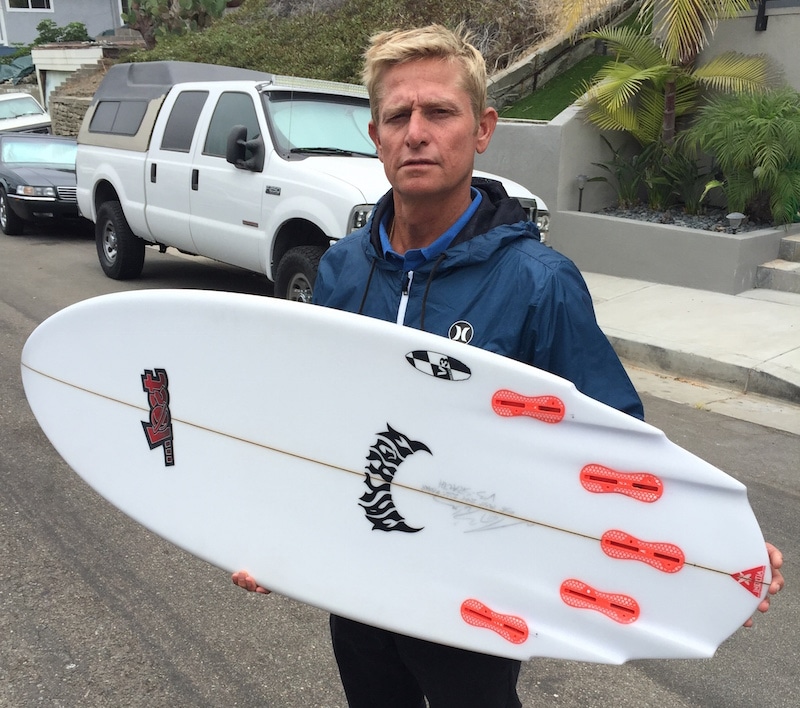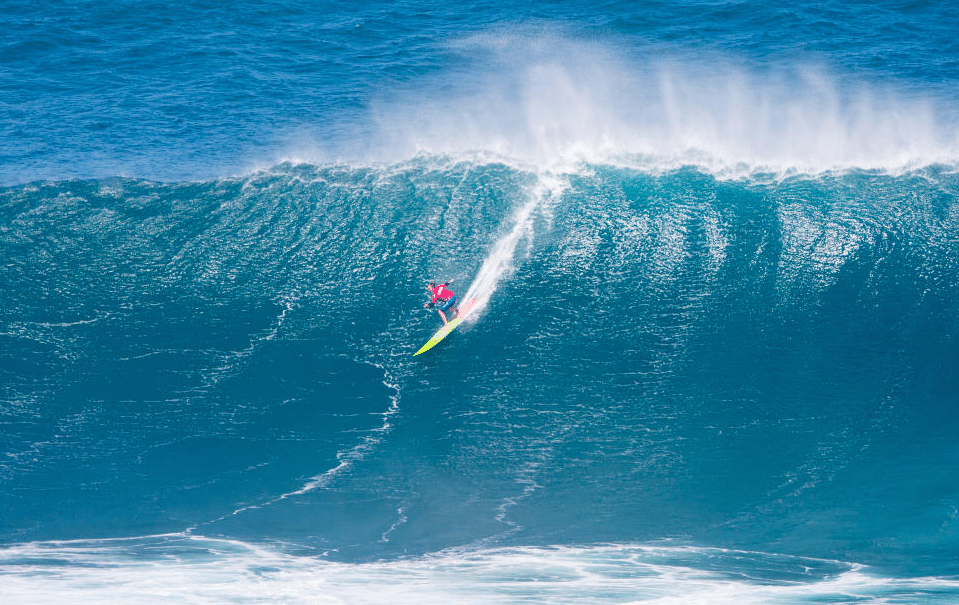Oh, the channel bottom is the most beautiful thing on earth. How about we demystify it?
Did you hear? Channel bottoms are…back. Mason Ho rode a six-seven with four-channels at last week’s Sunset contest, used the board in every heat, and won the event.
Mick Fanning? Won J-Bay on a DHD-designed channel bottom.
Meanwhile, Dan Thompson, the Firewire/Slater Designs guy who made the magic Sci-Fi for Stu Kennedy at Snapper, engineers his high-tech shapes with channels through the tail.
So how much do you know about the aesthetically sexy, if misunderstood, design? I rode one of ’em for years, a six-ish foot, six-channel bottom from Allan Byrne, the most famous from the school of deep channels. Used it for a year, and nothing else, while living on a beach in France. Two foot, six foot. Whatever. I liked it. Fast. A feeling of security and grip and power in turns, sturdy as a sailor in the tube. Maybe it was the shape, maybe it was the channels. Real hard to decipher unless you’re making identical boards, one with a flat bottom, the other channelled.
Recently, the San Clemente-based shaper Matt “Mayhem” Biolos brought out a line of channel bottoms, a gorgeous little Baby Buggy with curved channels. I figure he knows enough about the game, about what is faddish, and what works, to explain, and maybe demystify, the ancient design.
BeachGrit: How about explaining, for a lot of surfers who grew up riding concaves, what a channel bottom actually is?
Biolos: Well, first, I’m gonna refrain from the knockdown, dragged-out history of channel bottoms. This is no encyclopedic nor overly technical hydrodynamic/aerodynamic explanation.
I’m gonna keep it simple.
Channels are a design tool to cut paths for water and air to pass quickly, with forced direction, though the bottom curves of a surfboard. Similar to concaves, of course, but more dramatic and usually more focused. On a macro level, there tends to be be two styles of channels. Belly channels, which don’t exit the tail and are usually set forward of the fin cluster and tail channels which start just forward of the fins and run the length of the tail, usually, but not always, exiting though the tail of the board. Let me explain, one by one.
1. Belly channels were popular in the eighties, before boards transitioned to using concave hulls from vee bottoms. These boards tended to sit lower in the water and the vee could drag in small surf so, looking for lift and planing in lacklustre surf, shapers started cutting channels through hull the board, between the feet, to help direct the flow of water, and air, through the rocker and vee of the board.
These belly channels were cut into boards in myriad of ways and sort of died out with the popularity of full concave bottoms in surfboards during the early nineties. Why? The concave cut through the rocker in a much more radical and effective way. Very recently, and with no really noticeable, recent precedence, DHD went and started cutting belly channels into some boards for Mick Fanning. I assume they were trying to allow Mick to keep a lot of central curve in small wave rockers and get a bit at once speed and squirt through them. It seemed to work, as he won J-Bay on one.
2. The tail channels were really popular in the late eighties and early nineties. “Deep Six” channels cut up to 1/2” deep and exiting the tail, with radical wings cut into the outline in their wake. In our corner of the world, southern Californi, they were a huge fad, popularized by the local hero of heroes, Matt Archbold. He came home from Australia with some of these boards shaped by, I think, Terry “Richo” Richardson. The late Al Byrne gets a lot of credit for his work shaping, and his personal surfing performance on these types of boards, but in San Clemente, it was all about Archy, and Timmy Patterson, who made an art of shaping them. We all followed suit with vigour.
I was in my first few years of shaping and did hundreds of them. Took a full quiver of poorly shaped ones for myself to Hawaii in Fall of eighty-nine!
Anyways, for me at least, it’s easy to explain that the tail channels really took off as a way to cut through the recent advent of hyper-extended tail rockers. With the advent of concave bottoms, it was now much easier to use a new found amount of really kicked tail rocker in surfboards.
The true modern surfboard, with guys like Kelly, Archy, Herring etc, were using these extreme tail rockers to fit into new parts of waves. By cutting the channels deeply though the tail curve, you could really “channel” the water and, for better or for worse, air through the tail. The back foot feels like a gas pedal. The harder you push, the more is pushes back. Even with radical amounts of tail lift, the boards shoot forward with bursts of almost sketchy speed, rather than bog or sink or turn under the rear-foot pressure. In hollow, glassy waves the effect is the best. The clean, smooth water sucking up the wave face grips and attaches itself, gripping to the edges and surfaces of the channel forcing all the pressure and directing it directly out the back of the board.
Like any radical design in almost any genre, the more extreme it is, the less circumstances it will excel in. Choppy surfaces tend to make it difficult to keep the water attached to the channels , letting air in and causing all sorts of unexpected lift and unsettled feeling under the rear foot. When cut into a board, they also tend to remove a lot of foam and floation, and unless really pre-planned, which makes for tails that can sink or drag in small gutless surf. Wide tails and thicker pre-shaped foils can alleviate this.
A couple of years ago, while shaping in Bali, I stumbled upon some of Al Byrne’s amazing six-channels at the factory we work in and decided to design a simpler, less radical four-channel version. Using a slightly wider tail template than a typical hollow wave step-up, we began building and testing them with surfers around Indo. The response was good. We gave ours the name “Trouble Shooter”. Lots of tail rocker, a fairly relaxed entry and forward outline, made for an easy riding, but radical feeling , board in typical Indo surf. We put in in our line of boards, but with little to no fanfare, and almost zero sales.
Two years later, Mike Ho, who had been riding these in Hawaii, asked me to sneak a couple into masons Fall ’16 quiver. We sent them over last month, and Mason used a 6’7” Swallow tail “trouble Shooter” with four deep channels “radiating” out the tail, to win the HIC Sunset beach 3000 last week. Mason said it “felt like a twin-fin but held in”, whatever that means.
Finally,
A third, and almost uniquely different, genre of tail channel has sprung to prominence recently. I am taking some liberty here, but the designs of Dan Thompson, popularised by the surfing of Stu Kennedy (and Dan himself for that matter) are almost a design unto itself. It seems to me that Danny is using his channels to add an exhaust/release valve to his fast and flattish tail rockers. He’s pretty technical, with all sorts of engineering and time/space theories in his design explanations, but broken down simply, that’s what it looks like to me. A lot of shapers have done it over the years, but no one to the extreme focus and success of Tomo. He really worked on those things for a long time.
I call them “release valve channels” and we had a model, The “Scorch-It” about six years ago, using them. The model tanked, but it was actually really good. A spin off of our Stealth model, which was selling great at the time. No one had an interest in channels, and it fell on deaf ears.
Whatever his concept is behind these designs, I was inspired to go back and play around with flat tail rockers, for speed and drive, and steeply angled channels just in the rear bit of the tail to allow water to release in turns. The idea was to allow a flat-rocker board to easily surf vertical and in the pocket (square peg fitting and a round hole). They also add a bit of grip.

Tomo’s boards must be the most popular channel bottoms in the world right now. And from my point-of-view are almost the opposite theory of the more classic channels described in #1 and #2 above. He also uses extreme narrow concaves as if they were channels, which is something that has floated around, design-wise, since the Bonzer, even before.
We have been inspired to mix the two concepts and start our “Radiating 4” (R4) tail channels further back in the tail, with a steeper, angle, up and out of the tail. The idea is to cut through the rocker – and then release the water flow in a shorter arc for every-day waves where quicker turns are required.
We have added these “R4” channels to our Baby Buggy and a new, re-designed, Stealth, based off of our V3_Rocket and our original “Stealth” model. It’s a lot of fun. I have also been working for the last six months on an updated Puddle Jumper, which has a very low tail-rocker, and added a half-moon cut out and release valve channel to the tail. The results in small, gutlees trestles have been incredible, at least for my personal, domesticated surfing.

BeachGrit: Why would you get a channel bottom instead of the usual single through to a double concave?
Biolos: For fun mainly, but in good clean powerful surf that lack of concave in the rear third of the board feels much more positive. If you keep the extreme tail rocker, with a lack of concave it may tend to slow down the board, and keep it from projecting under rear-foot pressure, mainly opting to sit in the bowl and surf critical. By adding some channels through the curve, you can re-gain the thrust and directional force without the skitzy lift of typical double or a deep single concave. The rail-to-rail concaves don’t direct the water flow so much as add lift.
BeachGrit: Can you describe the…feeling? Can you compare the feeling to a concave? ‘Cause, theoretically, they’re not world’s apart, right?
Biolos: Didn’t I just do that? Jesus. The channels really give direction to the thrust. The concaves, and I’m generalising here, are more for lift.
BeachGrit: Hell of a thing to shape and glass, historically. Maybe not shape anymore ‘cause you got the machine. But are your glassers and sanders suicidal? When did you break the news to ‘em that you were launching a channel bottom? Did you do it over tequila?
Biolos: Even with most machines, shaping is just as tedious as sanding. I try to pump my shapers/sanders up with two points…
1. It’s a premium product. And we are paying a premium up-charge to the shapers/sander, with is designed to keep their hourly/daily income the same, or better, when shaping or sanding a bunch of channel bottoms.
2. It’s a less repetitive day of work. Meaning less boring. If a sander spends six hours sanding ten standard surfboard – that repeating the same thing 10 times in a day, day after day, boring. But if you’re shaping (or sanding) six or seven channel bottoms in that same day, and making at least the same amount, or more money, then you now have a much less repetitious day, and you;re now creating a more visually and mentally stimulating product, which makes for a less boring work day.
BeachGrit: Speaking of, how much extra work goes into the channel bottoms you make and what kinda premium do they have price-wise?
Biolos: I would say that one of our typical Radiating 4 channels takes half again as long as the finished shape itself. So the labor of shaping is about 50% more. The same goes for the sanding. the lamination is probably a 25% time-added expense, as well. The costs we upcharge tend to only cover my added expenses and I pretty much sub-margin these things, making even less percentage of profit on these than typical boards.
BeachGrit: Do the WSL guys ride ‘em? Brother, Carissa? They going to use ‘em in big contests?
Biolos: Brother just ordered some for freesurfing between seasons, after Pipe, up til Snapper, but I would not expect to see him ride them in contests. Carissa? Damn, now I wish I made her a couple for Honolua Bay. They would go incredible out there. You could use sooo much curve and not lose drive. With the pressure of the world title gone, she would probably do it. I blew it! But like I said above, Mason Ho just won the WSL 3000 at solid Sunset Beach on a 6’7” channel bottom. I would guess that makes him the second surfer, after MF at J-Bay, to win a legit WSL event on a channel bottom in a long long time.
BeachGrit: Tell me about your channels, specifically. Why not the shallow four, or the deep six etc.
Biolos: I think, the four (instead of six) makes for less specific conditions needed for the board to excel. By leaving a flat planing surface where the front fins are, it gives a more conservative feel under foot in sub-par waves, while still cutting through the curve of the tail. Also, my four channels all radiate in towards the nose a bit. The outer channels run parallel with the front fins and the inner channels use half that amount of toe towards the nose, matching what a quad fin would have, whether it has quads or not.
I simply feel that this set up makes for a more turning friendly board. It may not be as radically fast in projecting, as parallel channels, but like the whole thruster concept, they lock in and work best when one of the rails/fins is committed. They’re more forgiving and work better in turns. They also feel less stiff in small or sluggish surf and work with the quick pumping motion that most of us surf with in the modern era. Thats not to say that straight channels at G-land, J-Bay or any fast, down the line wave don’t work incredible.
‘Cause they do.
They fly.







